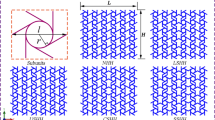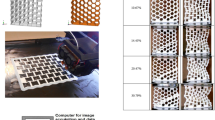Abstract
Based on the symmetric re-entrant honeycomb (S-RH) structure with negative Poisson’s ratios, a novel asymmetric and rotatable re-entrant honeycomb (AR-RH) structure was proposed. Both the S-RH structure and AR-RH structure were produced by the 3D printing technology. Through experimental test and finite element simulation, the deformation mechanism and energy absorption characteristics of the AR-RH structure and the S-RH structure with negative Poisson’s ratios at different impact velocities were compared. The experimental test and finite element simulation results show that the novel AR-RH structure with negative Poisson’s ratios has stronger energy absorption capacity than the S-RH structure, and it has been verified that the rotatability of AR-RH can indeed absorb energy. Furthermore, the degree of asymmetry of the AR-RH structure was discussed.














Similar content being viewed by others

References
Fu M-H, Chen Y, Hu L-L. A novel auxetic honeycomb with enhanced in-plane stiffness and buckling strength. Compos Struct. 2017;160:574–85.
Zhang X, Ding H, An L, Wang X. Numerical investigation on dynamic crushing behavior of auxetic honeycombs with various cell-wall angles. Adv Mech Eng. 2015;7(2):679678.
Huang J, Zhang Q, Scarpa F, Liu Y, Leng J. In-plane elasticity of a novel auxetic honeycomb design. Compos B Eng. 2017;110:72–82.
Imbalzano G, Tran P, Ngo TD, Lee PV. A numerical study of auxetic composite panels under blast loadings. Compos Struct. 2016;135:339–52.
Boldrin L, Hummel S, Scarpa F, Di Maio D, Lira C, Ruzzene M, et al. Dynamic behaviour of auxetic gradient composite hexagonal honeycombs. Compos Struct. 2016;149:114–24.
Liu Y, Hu H. A review on auxetic structures and polymeric materials. Sci Res Essays. 2010;5(10):1052–63.
Yang W, Li Z-M, Shi W, Xie B-H, Yang M-B. Review on auxetic materials. J Mater Sci. 2004;39(10):3269–79.
Evans KE. Auxetic polymers: a new range of materials. Endeavour. 1991;15(4):170–4.
Thill C, Etches J, Bond I, Potter K, Weaver P. Morphing skins. Aeronaut J. 2008;112(1129):117–39.
Martin J, Heyder-Bruckner JJ, Remillat C, Scarpa F, Potter K, Ruzzene M. The hexachiral prismatic wingbox concept. Physica Status Solidi (b). 2008;245(3):570–7.
Masters I, Evans K. Models for the elastic deformation of honeycombs. Compos Struct. 1996;35(4):403–22.
Spadoni A, Ruzzene M, Scarpa F. Dynamic response of chiral truss-core assemblies. J Intell Mater Syst Struct. 2006;17(11):941–52.
Hassan M, Scarpa F, Ruzzene M, Mohammed N. Smart shape memory alloy chiral honeycomb. Mater Sci Eng A. 2008;481:654–7.
Bornengo D, Scarpa F, Remillat C. Evaluation of hexagonal chiral structure for morphing airfoil concept. Proc Inst Mech Eng Part G J Aerosp Eng. 2005;219(3):185–92.
Scarpa F, Burriesci G, Smith F, Chambers B. Mechanical and electromagnetic behaviour of auxetic honeycomb structures. Aeronaut J. 2003;107(1069):175.
Frost HJ, Ashby MF. Deformation mechanism maps: the plasticity and creep of metals and ceramics. Oxford: Pergamon Press; 1982.
Choi J, Lakes R. Analysis of elastic modulus of conventional foams and of re-entrant foam materials with a negative Poisson’s ratio. Int J Mech Sci. 1995;37(1):51–9.
Zhang Z, Hu H, Xu B. An elastic analysis of a honeycomb structure with negative Poisson’s ratio. Smart Mater Struct. 2013;22(8):084006.
Zied K, Osman M, Elmahdy T. Enhancement of the in-plane stiffness of the hexagonal re-entrant auxetic honeycomb cores. Physica Status Solidi (b). 2015;252(12):2685–92.
Zhang X-C, Liu Y, Li N. In-plane dynamic crushing of honeycombs with negative Poisson’s ratio effects. Explos Shock Waves. 2012;32(5):475–82.
Hou X, Deng Z, Zhang K. Dynamic crushing strength analysis of auxetic honeycombs. Acta Mech Solida Sin. 2016;29(5):490–501.
Lu Z, Zhao Y. A two-dimensional multi-cell material mechanics model with negative Poisson’s ratio effect. J Beijing Univ Aeronaut Astronaut. 2006;32(05):594–7.
Shi Q. Performance characterization and optimum design of negative Poisson ratio honeycomb core. Doctoral dissertation, Harbin Institute of Technology, 2014.
Fan X, Yin X, Tao Y. Mechanical behavior and energy absorption of graded honeycomb materials under out-of-plane dynamic compression. Guti Lixue Xuebao/Acta Mech Sol Sin. 2015;36:114–22.
Panda B, Leite M, Biswal BB, Niu X, Garg A. Experimental and numerical modelling of mechanical properties of 3D printed honeycomb structures. Measurement. 2018;116:495–506.
Wang Z. Recent advances in novel metallic honeycomb structure. Compos B Eng. 2019;166:731–41.
Testing ASf, Materials, editors. D638-08: Standard Test Method for Tensile Properties of Plastics;2008. ASTM.
Gibson LJ, Ashby MF. Cellular solids: structure and properties. Cambridge: Cambridge University Press; 1999.
Tan PJ, Reid SR, Harrigan JJ, Zou Z, Li S. Dynamic compressive strength properties of aluminium foams. Part I–experimental data and observations. J Mech Phys Solids. 2005;53(10):2174–205.
Zhu H, Thorpe S, Windle A. The effect of cell irregularity on the high strain compression of 2D Voronoi honeycombs. Int J Solids Struct. 2006;43(5):1061–78.
Zhu HX, Mills N. The in-plane non-linear compression of regular honeycombs. Int J Solids Struct. 2000;37(13):1931–49.
Acknowledgements
This work is supported by the State Key for Strength and Vibration of Mechanical Structures of Xi’an Jiaotong University (No. SV2018-KF-32) and the Natural Science Foundation of Guangdong Province of China (2020A1515011064).
Author information
Authors and Affiliations
Corresponding authors
Ethics declarations
Data availability statement
All data, models and code generated or used during the study appear in the submitted article.
Rights and permissions
About this article
Cite this article
Xi, H., Xu, J., Cen, S. et al. Energy Absorption Characteristics of a Novel Asymmetric and Rotatable Re-entrant Honeycomb Structure. Acta Mech. Solida Sin. 34, 550–560 (2021). https://doi.org/10.1007/s10338-021-00219-x
Received:
Revised:
Accepted:
Published:
Issue Date:
DOI: https://doi.org/10.1007/s10338-021-00219-x



